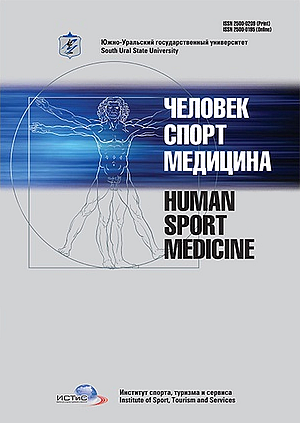METHOD FOR PHYSICAL CONDITIONING OF PRE-SCHOOL-AGE FOOTBALL PLAYERS
Keywords:
Football, physical conditioning, main movements, physical qualities, special motor capacity, methods.
Abstract
Aim. To develop and justify the method for physical conditioning of 6–7-year-old children practicing football at the sporting and health-promoting stage. Materials and Methods. Twelve 6–7-year-old children attending the health-promoting sports group in the youth sports school Dinamo (Omsk region) took part in the research. Motor, physical, and functional activity levels of the participants were assessed in the beginning of the academic year using the method suggested by Kravchuk (1998). Based on the obtained data of educational testing, we determined the content and sequence of physical conditioning for 6–7-year-old football players from the healthpromoting sports group. Results. We analyzed the age-specific features of development of main movements, physical qualities, and special motor capacity in 6–7-year-old children attending the health-promoting football group. It was established that arm movements, jumps, climbing, and throwing were not fully developed in the most subjects. Dexterity, endurance, dynamic strength, and speed strength levels were within age-specific normal limits, while agility, flexibility, and static strength values did not conform to age-specific standards for 6–7-year-old children. Generalized analysis of testing results revealed a significant heterogeneity (54% to 200%) in three indicators of motor fitness, one indicator of physical fitness, and two indicators of special motor fitness. The correlation analysis of the participants’ capacities revealed 18 of 171 potential correlations. Based on the obtained results we developed the method for physical conditioning at the sporting and health-promoting stage in football including three main modules of customized physical exercises considering mean group indicators of motor, physical, and special motor fitness as well as age-specific features of development of main movements and physical qualities in 6–7-year-old children. Conclusion. The method for physical conditioning of 6–7-year-old football players is determined based on features of age-specific and individual development of motor, physical, and special motor fitness of 6–7-year-old children. At the sporting and healthpromoting stage, the content of physical conditioning comprises physical exercises grouped into three modules and focused on complex formation of main movements and development of weaker physical and special motor qualities prior to relatively leading ones.References
1. Arkaev L.Ya., Suchilin N.G. [Methodological Foundations of the Modern System of Training Gymnasts of the Highest Class]. Teoriya i praktika fizicheskoy kul'tury [Theory and Practice of Physical Culture], 1997, no. 11, pp. 17–25. (in Russ.)
2. Bal'sevich V.K. Ontokineziologiya cheloveka [Ontokinesiology of Man]. Moscow, Theory and practice of physical culture Publ., 2000. 275 p.
3. Kanygin S.V. [The Effectiveness of Training Young Players 5–6 Years in the Sports and Fitness Stage of Training]. Teoriya i praktika fizicheskoy kul'tury [Theory and Practice of Physical Culture], 2016, no. 2, p. 39. (in Russ.)
4. Kurnakov S.V., Kurnakova N.P. [Integrated Training of Children of 4–6 Years of Football Technology at the Initial Stage of Development]. Fizkul'turnoe obrazovanie Sibiri: nauchno-metodicheskiy zhurnal [Physical Education of Siberia. Scientific and Methodical Journal], 2012, no. 1 (29), pp. 40–43. (in Russ.)
5. Kravchuk A.I. Fizicheskoe vospitanie detey rannego i doshkol'nogo vozrasta (nauchno-metodicheskie i organizatsionnye osnovy garmonichnogo doshkol'nogo kompleksnogo fizicheskogo vospitaniya) [Physical Education of Children of Early and Preschool Age (Scientific-Methodological and Organizational Basis of Harmonious Preschool Complex Physical Education)]. Novosibirsk, NGPU Publ., 1998. 238 p.
6. Mel'nikova Yu.A., Mukhina M.P., Mel'nikov K.V. [Peculiarities of the Development of the Basic Movements and Physical Qualities of Children of Senior Preschool Age, Engaged and Not Engaged in Sports Sections]. Fizicheskaya kul'tura, sport – nauka i praktika [Physical Culture, Sport – Science and Practice], 2014, no. 2, pp. 34–37. (in Russ.)
7. Mel'nikova Yu.A., Mukhina M.P. [Motor Readiness of Young Skaters of Initial Training Groups of the First Year of Training]. Fizkul'turnoe obrazovanie Sibiri [Physical Education of Siberia], 2015, no. 1, pp. 113–116. (in Russ.)
8. Shagin N.I. [Determination of the Relationship Between the Overall Physical and Technical Preparedness of Boys 5–6 Years Old, Engaged in Football]. Fizicheskaya kul'tura: vospitanie, obrazovanie, trenirovka [Physical Culture. Education, Education, Training], 2015, no. 5, p. 18. (in Russ.)
2. Bal'sevich V.K. Ontokineziologiya cheloveka [Ontokinesiology of Man]. Moscow, Theory and practice of physical culture Publ., 2000. 275 p.
3. Kanygin S.V. [The Effectiveness of Training Young Players 5–6 Years in the Sports and Fitness Stage of Training]. Teoriya i praktika fizicheskoy kul'tury [Theory and Practice of Physical Culture], 2016, no. 2, p. 39. (in Russ.)
4. Kurnakov S.V., Kurnakova N.P. [Integrated Training of Children of 4–6 Years of Football Technology at the Initial Stage of Development]. Fizkul'turnoe obrazovanie Sibiri: nauchno-metodicheskiy zhurnal [Physical Education of Siberia. Scientific and Methodical Journal], 2012, no. 1 (29), pp. 40–43. (in Russ.)
5. Kravchuk A.I. Fizicheskoe vospitanie detey rannego i doshkol'nogo vozrasta (nauchno-metodicheskie i organizatsionnye osnovy garmonichnogo doshkol'nogo kompleksnogo fizicheskogo vospitaniya) [Physical Education of Children of Early and Preschool Age (Scientific-Methodological and Organizational Basis of Harmonious Preschool Complex Physical Education)]. Novosibirsk, NGPU Publ., 1998. 238 p.
6. Mel'nikova Yu.A., Mukhina M.P., Mel'nikov K.V. [Peculiarities of the Development of the Basic Movements and Physical Qualities of Children of Senior Preschool Age, Engaged and Not Engaged in Sports Sections]. Fizicheskaya kul'tura, sport – nauka i praktika [Physical Culture, Sport – Science and Practice], 2014, no. 2, pp. 34–37. (in Russ.)
7. Mel'nikova Yu.A., Mukhina M.P. [Motor Readiness of Young Skaters of Initial Training Groups of the First Year of Training]. Fizkul'turnoe obrazovanie Sibiri [Physical Education of Siberia], 2015, no. 1, pp. 113–116. (in Russ.)
8. Shagin N.I. [Determination of the Relationship Between the Overall Physical and Technical Preparedness of Boys 5–6 Years Old, Engaged in Football]. Fizicheskaya kul'tura: vospitanie, obrazovanie, trenirovka [Physical Culture. Education, Education, Training], 2015, no. 5, p. 18. (in Russ.)
References on translit
Published
2017-06-01
How to Cite
Melnikova, Y., & Melnikov, N. (2017). METHOD FOR PHYSICAL CONDITIONING OF PRE-SCHOOL-AGE FOOTBALL PLAYERS. Human. Sport. Medicine, 17(2), 81-88. https://doi.org/10.14529/hsm170208
Issue
Section
Sports training
Copyright (c) 2019 Human. Sport. Medicine

This work is licensed under a Creative Commons Attribution-NonCommercial-NoDerivatives 4.0 International License.















